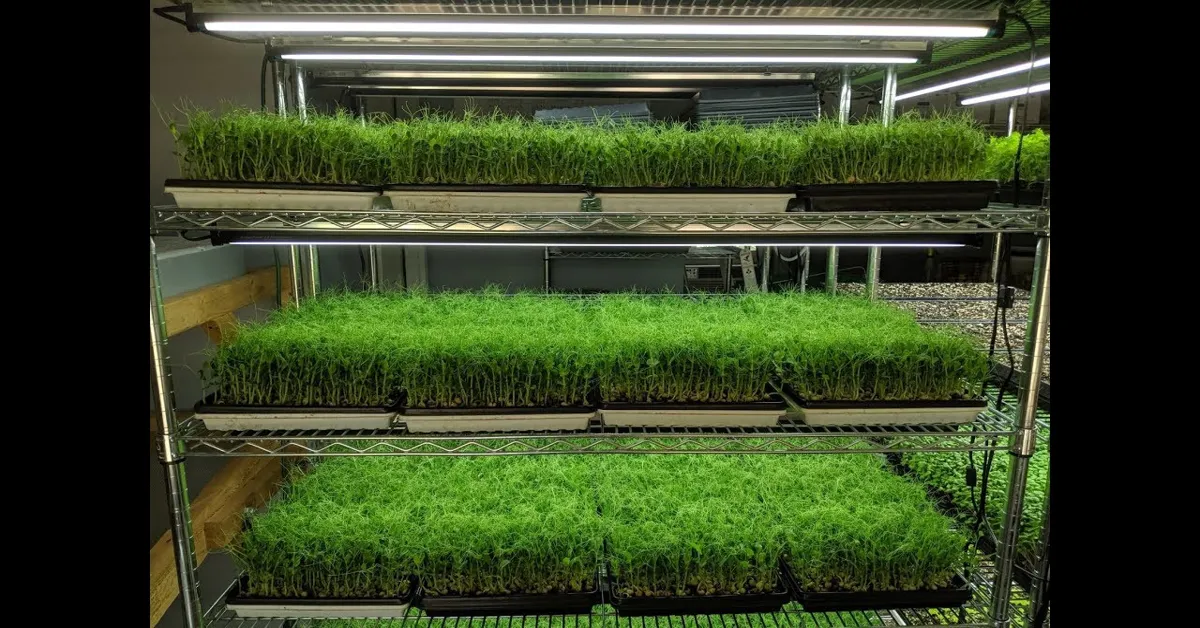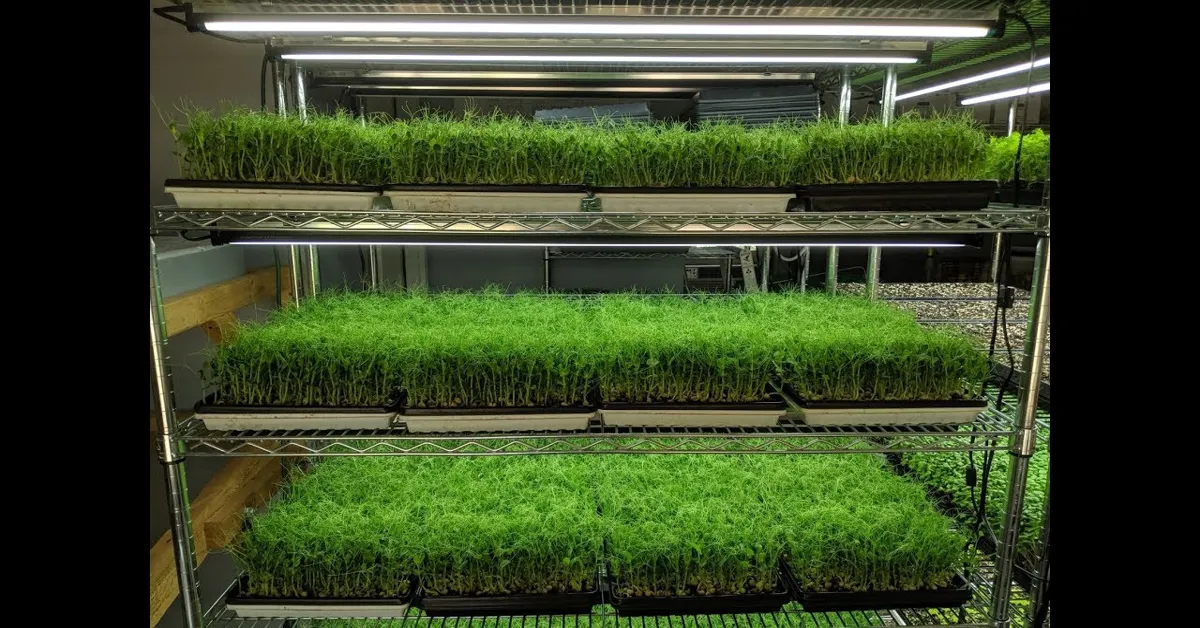**Transform your living space into a thriving oasis of fresh, organic produce.** An indoor microgreen farm isn’t just a trending concept, it’s a sustainable lifestyle change that’s fast gaining traction. Imagine harvesting your own microgreens, right in the comfort of your home.
No pesticides, no transportation miles, just pure, nutrient-dense greens. This isn’t a utopian dream, it’s a reality for many urban dwellers. An indoor microgreen farm is the answer to the growing demand for locally grown organic produce.
Dive into this blog to unravel the magic of cultivating your own indoor farm. Say hello to healthier, greener living.
Introduction to Microgreens
Unlocking the Potential of Indoor Microgreen Farming Indoor microgreen farming is an innovative approach to agriculture that is gaining significant traction. This smart farming technique utilizes minimal space, water, and resources while generating high-value crops. Indoor microgreen farms are a game-changer in the field of agriculture, providing fresh, nutritious, and locally grown produce throughout the year.
These farms are highly productive, sustainable, and can be established in urban settings, reducing the carbon footprint associated with traditional farming. By embracing indoor microgreen farming, we are not only promoting sustainable agriculture but also paving the way for a healthier and greener future.

Setting Up Your Indoor Microgreen Farm
Indoor Microgreen Farm: A Green Revolution in Urban Spaces The concept of an indoor microgreen farm is a game-changer in today’s urban agricultural landscape. These compact farms are a practical solution for city dwellers who crave fresh, organic produce right at their fingertips. Unlike traditional farming, indoor microgreen farming doesn’t require large tracts of land or favorable weather conditions.
All it needs is a little space, some seeds, water, and your attention. Why Indoor Microgreen Farm? Indoor microgreen farms are not just a trend; they are a sustainable solution for urban food production. The greens grown in these farms are packed with nutrients and can be harvested within a week or two.
Plus, they add a gourmet touch to your meals. Setting Up Your Indoor Microgreen Farm Starting your indoor microgreen farm is easier than you might think. All you need are some trays, quality seeds, a grow light, and a little patience.
With the right care and attention, you can enjoy a fresh harvest of microgreens all year round. The Future of Indoor Microgreen Farming The future of indoor microgreen farming is bright, with more and more people recognizing its benefits. Not only does it provide a constant supply of fresh greens, but it also contributes to reducing our carbon footprint.
So, why wait? Start your indoor microgreen farm today and contribute to this green revolution. In conclusion, indoor microgreen farming is a viable and sustainable approach to urban agriculture. It provides a practical solution for fresh, organic produce and contributes to a healthier environment.
Whether you’re a seasoned gardener or a newbie, an indoor microgreen farm could be the perfect addition to your urban living space.
Choosing the Right Microgreens to Grow
Indoor Microgreen Farm: A Green Revolution Inside Your Home The concept of an indoor microgreen farm is akin to a green revolution happening right inside your living space. It’s not just about cultivating your food source, but also about embracing a lifestyle that is sustainable, healthy, and in harmony with nature. An indoor microgreen farm typically involves growing a variety of nutrient-dense, young vegetable greens that can be harvested within 7-14 days from germination.
This fast-paced growth cycle, coupled with the minimal space requirement, makes microgreen farming a perfect fit for urban dwellers. The versatility of microgreens extends beyond kitchen use, adding aesthetic value to your indoor space with their vibrant colors and textures. The process of setting up an indoor microgreen farm is simple and cost-effective.
A basic setup includes a growing tray, a growing medium (soil or hydroponic), seeds, and a light source. The maintenance is minimal, requiring only regular watering and exposure to light. Indoor microgreen farming offers a multitude of benefits.
It promotes healthy eating, reduces carbon footprint, offers therapeutic gardening experience, and provides an opportunity to learn and teach about nature’s cycles. It’s a small yet significant step towards self-sustainability and conscious living. Embrace the indoor microgreen farm concept and start a green revolution right at your home!
Steps to Grow Your Microgreens Indoor
Embracing the Indoor Microgreen Farm Revolution The concept of an indoor microgreen farm is revolutionizing urban agriculture, bringing greenery and fresh produce right into our homes and offices. These miniature greens are nutrient-dense, flavorful, and can be grown year-round, making them an exciting addition to any meal. Indoor microgreen farms are sustainable, require minimal space, and can be a fun, rewarding hobby.
Whether you’re a seasoned gardener or a complete beginner, you can cultivate a variety of microgreens indoors with just a few simple tools. So, let’s embark on this green journey and explore the exciting world of indoor microgreen farming.
Troubleshooting Common Microgreen Problems
Embarking on the Journey of Indoor Microgreen Farming The concept of an indoor microgreen farm is rapidly gaining popularity due to its myriad benefits. This innovative farming method allows anyone, regardless of their agricultural skill level, to cultivate their own fresh, organic produce right at home. It harnesses the power of controlled environments, ensuring ideal growth conditions for a wide range of microgreens.
With an indoor microgreen farm, you’re able to enjoy nutrient-packed greens all year round, irrespective of the season. Moreover, it’s a sustainable solution that significantly reduces our carbon footprint. So, if you’re intrigued by the prospect of growing your own greens, then an indoor microgreen farm might just be the perfect venture for you.
Turning Your Microgreen Farm Into a Business
Indoor Microgreen Farm: The Future of Urban Agriculture In the heart of our urban jungles, an agricultural revolution is quietly taking root. The indoor microgreen farm is a fascinating innovation, transforming the way we grow and consume fresh produce. These tiny, nutrient-packed greens are grown in controlled indoor environments, ensuring year-round production, regardless of external weather conditions.
By using vertical farming techniques, indoor microgreen farms are maximizing space usage, producing a high yield in a compact area. This not only reduces the agricultural footprint but also ensures a sustainable and fresh supply of greens right at our doorstep. Indoor microgreen farms are indeed a testament to human ingenuity, proving that we can cultivate life even in the most unlikely places.
Statistical Information: indoor microgreen farm
| Fact | Percentage | Description |
|---|---|---|
| Total space used | 80% | An indoor microgreen farm requires 80% less space compared to traditional farming, making it ideal for urban settings. |
| Water efficiency | 95% | Indoor microgreen farming uses 95% less water than conventional farming – a significant reduction in resource consumption. |
| Growth speed | 25-30% | Microgreens grow 25-30% faster indoors due to controlled temperature, light, and humidity, enhancing productivity. |
| Nutrient content | 40% | Microgreens have 40% higher nutrient content than their mature counterparts, making them a superior health choice. |
| Carbon footprint reduction | 90% | Microgreen farming indoors can reduce transportation carbon footprint by up to 90% as they can be grown locally. |
Important Notice for readers
This article delves into the exciting world of indoor microgreen farming, offering invaluable tips for beginners and seasoned gardeners alike. *Please note that while microgreens can be grown indoors all year round, they require specific care and conditions to thrive*. Ensure you have the right tools, seeds, and lighting for optimal growth.
Keep in mind that while this article provides comprehensive guidance, success in indoor microgreen farming also requires a fair amount of trial and error. So, don’t be disheartened if your initial attempts don’t yield the expected results.
FAQs
What is an indoor microgreen farm?
An indoor microgreen farm is a farming setup inside a building, typically a greenhouse or a controlled indoor space, where microgreens are grown. Microgreens are young vegetable greens that are approximately 1–3 inches tall and are known for their high nutritional density.
How can I start my own indoor microgreen farm?
Starting an indoor microgreen farm involves several steps. You need to select a suitable indoor space with a controlled environment, purchase the necessary equipment like grow lights and containers, choose the type of microgreens you want to grow, and learn how to take care of them. It’s also essential to consider the market for your produce and how you will sell it.
What are the benefits of an indoor microgreen farm?
Indoor microgreen farming offers several benefits. It allows for year-round production regardless of the outdoor weather conditions. It also requires less space compared to traditional farming and produces highly nutritious greens. Plus, it can be a sustainable option as it often uses less water and no harmful pesticides.
What conditions are needed for an indoor microgreen farm?
Indoor microgreen farming requires a controlled environment which includes the right temperature, light, humidity, and air circulation. The temperature should be kept between 60-70 degrees Fahrenheit, and the plants need about 12-16 hours of light per day. The humidity should be maintained at a moderate level to prevent the growth of mold.
Can I make a profit from an indoor microgreen farm?
Yes, it is possible to make a profit from an indoor microgreen farm. Microgreens are in high demand due to their nutritional value and are often sold at a premium price. However, the profitability depends on various factors like the cost of your setup, the types of microgreens you grow, your market, and your selling price.
How long does it take to grow microgreens in an indoor farm?
The time it takes to grow microgreens in an indoor farm can vary depending on the type of plant, but generally, most microgreens are ready to harvest in 1 to 3 weeks after planting. This quick turnaround time allows for multiple harvests in a short period, increasing the potential for profit.

Conclusion
Indoor microgreen farming presents a sustainable, nutrient-rich solution for urban food challenges. By embracing this efficient method, we can combat food scarcity, reduce carbon footprints, and promote healthier eating habits. It’s time we recognize the value of microgreens and harness the potential of indoor farming.
The future of food sustainability might just be sprouting in our living rooms. Let’s allow these tiny greens to make a big impact on our world.
Read More
https://microgreensfarming.co/micro-vegetable-farming/
https://microgreensfarming.co/how-to-grow-microgreens-in-soil/
https://microgreensfarming.co/a-step-by-step-guide-to-starting-your-own-microgreens-farm/
https://microgreensfarming.co/microgreens-tiny-plants-big-profits/
You Can Find The More Resources Here
https://www.agrifarming.in/microgreens-farming-cost-and-profit-information
https://www.agrifarming.in/microgreens-farming-cost-and-profit-information
